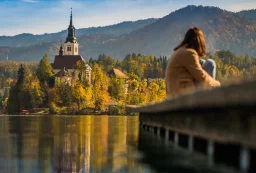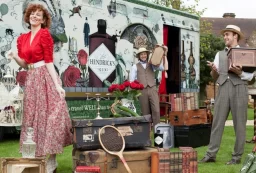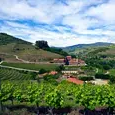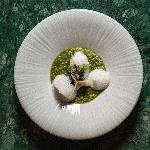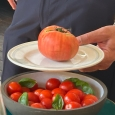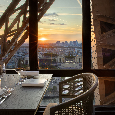
The Douro, Portugal’s famous River of Gold, starts its westward journey to the sea in France, crossing into Portugal at Barca d’Alva. From there it flow another 125 miles until it reaches the Atlantic at the historic city of Porto, home to Port Wine. No surprise, therefore, that on week’s river cruise, wine and port were never far away.
It’s this final section from the border to the sea that is popular with tourists and the many companies that offer cruises along this fascinating part of the river. Ranging from wide expanses of water to narrow atmospheric gorges, the river offers an enchanting, ever-changing vista.

Aboard the AmaWaterways cruise ship, cabins are quite elegant with lots of storage space, a marble bathroom with top-class fittings and l’Occitane spa quality toiletries. Bath robes and slippers are also provided and there was a small balcony where guests will often enjoy a cool nightcap before retiring to a large and comfortable bed.
The culinary experience is excellent as well with wine, beer and soft drinks included with lunch and dinner. At breakfast, sparkling wine was also available where guests indulge in a morning Bucks Fizz, although onboard it is known by its American name of Mimosa.
"The Douro, Portugal’s famous River of Gold, starts its westward journey to the sea until the historic city of Porto, home to Port Wine. No surprise, therefore, that on week’s river cruise, wine and port were never far away."
Before sailing next day, a morning tour of Porto included the local railway station, an unusual visitor attraction. It’s decorated with over 24,000 Azulejos – Portuguese blue ceramic tiles, and attracts as many tourists as it does passengers. Graham’s is also an interesting visit to one of the many Port companies in the city, where you’ll learned about the various types of port they produce, followed by a tasting of some of their vintages.

Port starts life as red wine but, during fermentation, neutral grape spirit, 77% alcohol by volume, is added. This stops the fermentation, leaving some residual sugar that gives port its sweet taste. Ruby port, the cheapest to make, is stored in large tanks which do not allow oxidisation, thus preserving its rich colour. Tawny ports are aged in wooden barrels and the slow oxidisation changes their colour to golden brown. Tawny ports are often described on the label as 10, 20 or 30 years old. This does not indicate the actual age, but an average of the wines that make up the blend.
After lunch on board and a gently stroll around the area it was time for a dinner excursion. Vinho Verde (meaning young, not green) is a famous local vintage and the nearby by Casa de Vila Verde is an ideal place to indulge along with a fine meal.

The Douro River is narrow and rocky in parts and most of the hilly banks of the river are dedicated to the growing of grapes for the production of wine and port. The rocky banks store heat during the summer months and in winter help to ward off the worst of the cold weather. Famous names along the river included Warres, Sandeman and Cockburn, dotted amongst the numerous Quintas (farms) that are home to the vineyards that supply local industry.
The Douro Museum in Regua is ideal for a visit as well where the area’s intriguing history is shared. Recommended is also Lamego and the 18th century Sanctuary of Our Lady of Remedies. Pilgrims climbed more than 600 steps to reach the sanctuary but fortunately our coach drove up to save us the effort.

The AmaWaterways ships goes far north just a few yards over the border into Spain to dock at Vega de Terron. The Spanish Renaissance city of Salamanca is around fifty miles from here and its University, founded in 1218 attracts many international students. Declared a UNESCO World Heritage Site in 1996, it shared the title of 2002 European Capital of Culture with Bruges.
The city is famous for having two cathedrals joined to each other, one built in the 12th century and the other in the 16th century. It’s also famous for its town square or Plaza Mayor, considered by many to be the most elegant in Spain.

Another exciting stop on the journey is Pinhao where guest visit the Croft’s Quinta da Roeda for lunch and sampled ‘pink port’. Croft developed Rosé port to attract a younger clientele; it’s drunk chilled on its own or as a base for cocktails. The days adventure includes a visit to the Palace of Mateus whose famous facade adorned those odd-shaped bottles of Mateus Rosé.
The final morning of the AmaWaterways voyage is spent admiring the increasingly busy banks of the river as passengers head back into Porto. After lunch on board, they’ll depart to visit Guimaraes. The city dates back to the 10th century and was home to a religious settlement in what was then Spain. In 1128 after the battle of Sao Mamede, the victorious Afonso Henriques declared Portugal’s independence; a new country was born and Afonso the First was its King.

Many guests will also visit the lovely Casa de Sezim and be greeted by the current owner, the house having been in his family since 1376. It has stunning and extremely rare 19th century hand-printed wallpaper whose colours are as bright today as they ever were, and the vineyards produce top quality Vinho Verde which I was happy to sample.

Guests will love AmaWaterways lovely ships, the meal, excursions and spending time with fellow passengers on the Enticing Douro itinerary. They’ll disembark full of new experiences and great memories of delicious food, history and culture, and generous quantities of wine and port.






